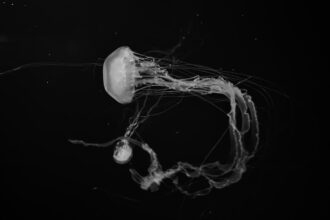Cavitation is a phenomenon that occurs when the pressure of a liquid drops below its vapor pressure, leading to the formation of vapor-filled cavities or bubbles. These bubbles can form in various conditions, particularly in high-velocity flows where pressure changes rapidly. When the pressure recovers, these bubbles collapse violently, producing shock waves that can cause significant damage to nearby surfaces.
This process is not only a concern in marine engineering but also in various industrial applications, such as pumps and turbines. Understanding the mechanics of cavitation is crucial for engineers and designers who aim to mitigate its adverse effects. The implications of cavitation extend beyond mere physical damage; it can also lead to performance inefficiencies in systems where fluid dynamics play a critical role.
In submarines, for instance, cavitation can generate noise that compromises stealth capabilities, making them more detectable to enemy sonar systems. As such, comprehending the fundamental principles of cavitation is essential for developing effective strategies to control and minimize its impact on underwater vessels.
Key Takeaways
- Cavitation is the formation and collapse of vapor bubbles in a liquid, leading to intense pressure waves and potential damage to submerged structures.
- Cavitation can significantly impact the performance and stealth capabilities of submarines, making it a critical concern for naval operations.
- Traditional methods for controlling cavitation include altering propeller designs, adding fairings, and using sound-absorbing materials.
- Innovations in noise reduction technology, such as biomimetic designs and advanced coatings, show promise in mitigating cavitation effects on submarines.
- Advanced materials and hydrodynamic design improvements are being explored to better control cavitation and enhance submarine performance.
The Impact of Cavitation on Submarines
Cavitation poses a unique set of challenges for submarines, primarily due to its potential to generate noise and structural damage. The noise produced by cavitating propellers can be detected by sonar systems, which compromises the stealth advantage that submarines rely on for tactical operations. This acoustic signature can reveal a submarine’s position and movement, making it vulnerable to detection and attack.
Consequently, managing cavitation is not merely a technical issue; it is a matter of strategic importance in naval warfare. Moreover, the physical effects of cavitation can lead to material degradation over time. The repeated collapse of vapor bubbles creates shock waves that can erode propeller blades and other components, leading to increased maintenance costs and reduced operational efficiency.
Engineers must therefore consider both the immediate and long-term impacts of cavitation when designing submarines, ensuring that they remain effective and resilient in various operational environments.
Traditional Methods for Controlling Cavitation
Historically, engineers have employed several traditional methods to control cavitation in submarines. One common approach involves adjusting the operating conditions of the propeller, such as reducing its rotational speed or altering its pitch. By optimizing these parameters, it is possible to minimize the likelihood of cavitation occurring during operation.
However, this often comes at the cost of reduced thrust and overall performance, necessitating a careful balance between efficiency and cavitation control. Another traditional method involves the use of cavitation-resistant materials in critical components like propellers and hulls. These materials are designed to withstand the erosive effects of cavitation, prolonging the lifespan of submarine parts and reducing maintenance needs.
While these approaches have proven effective to some extent, they often require trade-offs that can limit a submarine’s operational capabilities. As technology advances, there is a growing need for more innovative solutions that address the challenges posed by cavitation without compromising performance.
Innovations in Noise Reduction Technology
| Technology | Advantages | Disadvantages |
|---|---|---|
| Active Noise Cancellation | Effectively reduces low-frequency noise | Requires power source |
| Passive Noise Isolation | No power source needed | Less effective for low-frequency noise |
| Adaptive Noise Control | Adjusts to different environments | Complex algorithms |
In recent years, significant advancements have been made in noise reduction technology aimed at mitigating the effects of cavitation on submarines. One notable innovation is the development of advanced acoustic coatings that can be applied to submarine hulls and propellers. These coatings are designed to absorb sound waves and reduce the acoustic signature generated by cavitating bubbles.
By minimizing noise emissions, submarines can operate more stealthily, enhancing their effectiveness in covert missions. Additionally, researchers have explored the use of active noise control systems that employ sensors and actuators to counteract unwanted sound waves generated by cavitation. These systems can dynamically adjust to changing conditions, providing real-time noise reduction that traditional methods cannot achieve.
Advanced Materials for Cavitation Control
The development of advanced materials has played a pivotal role in addressing the challenges posed by cavitation in submarines.
These materials not only enhance the durability of submarine components but also contribute to overall performance improvements by reducing weight and increasing efficiency.
Furthermore, nanotechnology has emerged as a promising avenue for creating materials with enhanced cavitation resistance. By manipulating materials at the molecular level, scientists can develop surfaces that are less prone to bubble formation and collapse. This innovative approach holds great potential for revolutionizing submarine design, offering solutions that were previously unattainable with conventional materials.
Hydrodynamic Design Improvements
Hydrodynamic design plays a crucial role in minimizing cavitation effects on submarines. Engineers are increasingly employing computational fluid dynamics (CFD) simulations to analyze fluid flow around submarine hulls and propellers. By understanding how water interacts with these surfaces, designers can optimize shapes and configurations to reduce turbulence and pressure fluctuations that lead to cavitation.
One significant improvement involves streamlining hull designs to enhance hydrodynamic efficiency. By reducing drag and optimizing flow patterns, submarines can operate at higher speeds without triggering cavitation. Additionally, propeller designs are being refined to ensure smoother water flow and minimize pressure drops that contribute to bubble formation.
These hydrodynamic advancements not only mitigate cavitation but also improve overall performance and fuel efficiency.
Propeller Design and Cavitation Control
The design of submarine propellers is critical in managing cavitation effectively. Traditional propeller designs often struggle with maintaining efficiency at high speeds due to the onset of cavitation. To address this issue, engineers are exploring new blade geometries that promote smoother water flow and reduce pressure differentials across the blades.
One innovative approach involves using skewed or twisted blades that help maintain a more uniform flow around the propeller. This design minimizes abrupt changes in pressure that can lead to bubble formation. Additionally, variable-pitch propellers allow for adjustments in blade angle during operation, enabling submarines to optimize thrust while minimizing cavitation risk across various speeds and conditions.
Active and Passive Noise Reduction Systems
Submarines are increasingly incorporating both active and passive noise reduction systems to combat the challenges posed by cavitation-induced noise. Passive systems typically involve sound-absorbing materials integrated into the submarine’s structure, which help dampen vibrations and reduce acoustic emissions. These materials can be strategically placed throughout the vessel to maximize their effectiveness without adding significant weight.
On the other hand, active noise reduction systems utilize advanced technology to counteract sound waves generated by cavitation. By employing sensors that detect noise patterns and actuators that produce opposing sound waves, these systems can effectively cancel out unwanted noise in real-time. The combination of both active and passive approaches provides a comprehensive solution for managing acoustic signatures, ensuring submarines remain stealthy even in challenging operational environments.
The Role of Computational Fluid Dynamics in Cavitation Control
Computational fluid dynamics (CFD) has revolutionized the way engineers approach cavitation control in submarines. By simulating fluid flow around various designs, CFD allows for detailed analysis of how changes in shape or configuration impact pressure distribution and bubble formation. This technology enables designers to identify potential cavitation hotspots before physical prototypes are built, saving time and resources during the development process.
Moreover, CFD simulations can be used to optimize not only hull shapes but also internal components such as piping systems and valves. By understanding how fluid behaves within these systems, engineers can make informed decisions about design modifications that minimize pressure drops and turbulence—key factors contributing to cavitation risk.
Future Trends in Cavitation Control for Submarines
As technology continues to advance, future trends in cavitation control for submarines are likely to focus on integrating multiple innovative approaches into cohesive systems. The combination of advanced materials, cutting-edge hydrodynamic designs, and sophisticated noise reduction technologies will create submarines that are not only more efficient but also significantly quieter. Additionally, ongoing research into artificial intelligence (AI) may lead to smarter systems capable of adapting in real-time to changing operational conditions.
AI algorithms could analyze data from sensors monitoring fluid dynamics and noise levels, allowing submarines to adjust their operations dynamically to minimize cavitation risk while maximizing performance.
Case Studies: Successful Implementation of Cavitation Control Innovations
Several case studies highlight successful implementations of innovations aimed at controlling cavitation in submarines. One notable example is the development of a new class of submarines equipped with advanced composite materials designed specifically for enhanced resistance to cavitation-induced erosion. These vessels have demonstrated significantly reduced maintenance costs and extended operational lifespans compared to their predecessors.
Another case study involves a naval program that integrated active noise control systems into existing submarine designs. By retrofitting these vessels with state-of-the-art sensors and actuators, engineers were able to achieve substantial reductions in acoustic signatures during high-speed maneuvers—effectively enhancing stealth capabilities without compromising performance. In conclusion, as the challenges posed by cavitation continue to evolve, so too will the strategies employed by engineers and designers in submarine technology.
Through a combination of traditional methods and innovative solutions, the future of submarine design promises enhanced performance while effectively managing the complexities associated with cavitation.
Cavitation, a phenomenon that can significantly impact the stealth and efficiency of submarines, has been a critical area of research and development in naval engineering. Advances in controlling cavitation have led to quieter and more efficient submarine operations, enhancing their strategic capabilities. For a deeper understanding of how these advancements have been implemented, you can explore a related article on this topic by visiting In The War Room. This article delves into the technological innovations and engineering solutions that have been developed to mitigate cavitation effects, ensuring submarines remain undetected and perform optimally in various underwater conditions.
WATCH THIS! America’s Nuclear Navy Was Born From Espionage
FAQs
What is cavitation?
Cavitation is the formation and collapse of vapor bubbles in a liquid, typically caused by rapid changes in pressure. This can occur on the surface of a submarine as it moves through water, leading to damage and noise.
How was cavitation controlled on submarines?
Cavitation on submarines was controlled through the design of the submarine’s propeller and hull. Engineers developed specialized propeller designs and hull shapes to minimize the formation of vapor bubbles and reduce the effects of cavitation.
Why is controlling cavitation important for submarines?
Controlling cavitation is important for submarines because it can cause damage to the propeller and increase the noise level, making the submarine more detectable. By minimizing cavitation, submarines can operate more stealthily and efficiently.
What are the consequences of uncontrolled cavitation on submarines?
Uncontrolled cavitation on submarines can lead to erosion and pitting of the propeller blades, reducing their efficiency and lifespan. It can also increase the acoustic signature of the submarine, making it easier for adversaries to detect and track.




